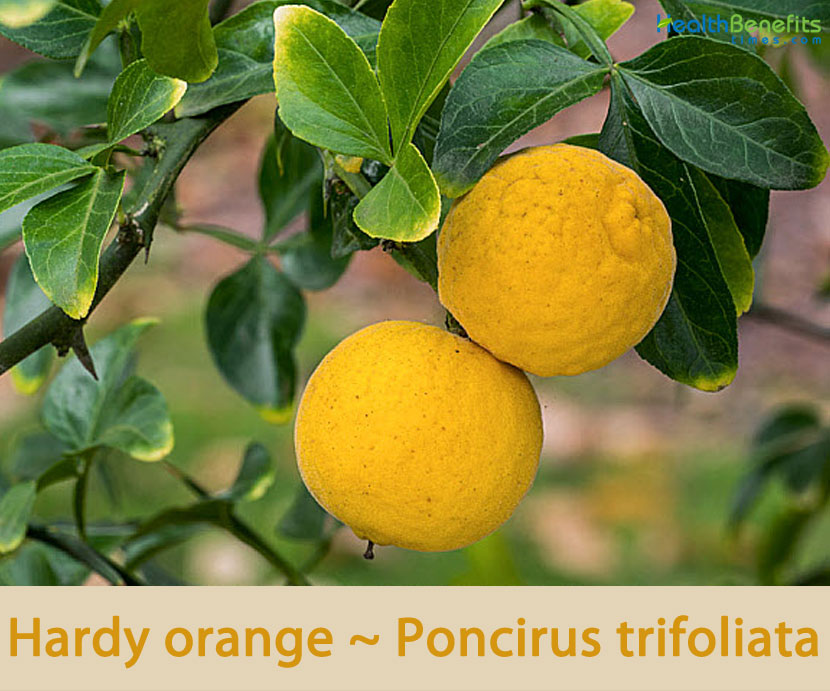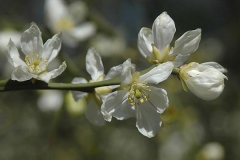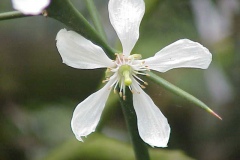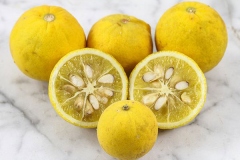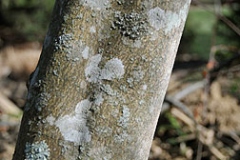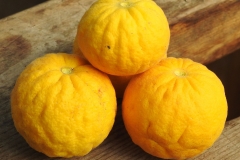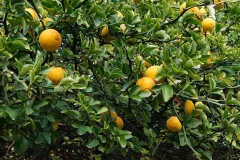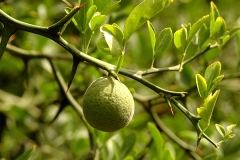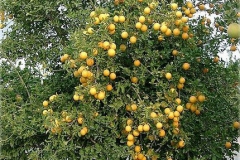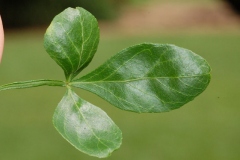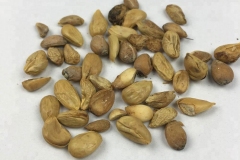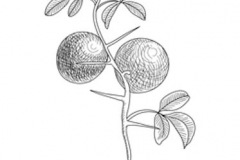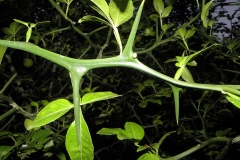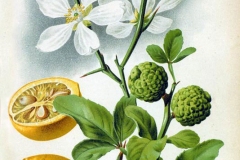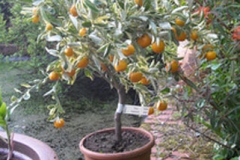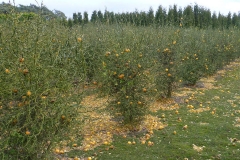Japanese Bitter oranges are different from other citrus varieties and are not considered true citrus, but are one of the few hardy orange varieties suited for colder climates. It is a popular ornamental tree in Asia and North America, used for their unusual twisted, tightly woven branches, and is also preferred for their hardiness, being used as parent fruit in breeding new citrus and being one of the oldest varieties of rootstock used in the citrus industry today. Its fruits are extensively used to alleviate symptoms of various disorders. The mature fruit possesses anticancer and anti-inflammatory activities. Extracts of the dried, immature fruit are widely used as a traditional medicine for ameliorating symptoms of digestive dysfunction in East Asia.
Hardy Oranges Facts
| Hardy orange Quick Facts | |
|---|---|
| Name: | Hardy orange |
| Scientific Name: | Poncirus trifoliata |
| Origin | North and Central China, Korean Peninsula and Japan |
| Colors | Green when young turning to yellow or yellowish orange when it matures |
| Shapes | Globose, hairy fruit that is about the size of a golf ball about 3–5 cm in diameter, rough, finely pubescent and fragrant. The rind has a downy coating that creates a fuzzy texture and is firm |
| Flesh colors | Greenish |
| Taste | Taste like a blend of lemon and grapefruit |
| Health benefits | Beneficial for toothache, colds, dyspepsia, constipation, abdominal distension, typhoid, toothache, hemorrhoids, conjunctivitis, hernia, sputum remedy and sinusitis |
| Name | Hardy orange |
|---|---|
| Scientific Name | Poncirus trifoliata |
| Native | North and Central China, Korean Peninsula and Japan |
| Common Names | Bitter Orange, Hardy orange, Trifoliate Orange, Japanese Hardy Orange, Japanese bitter-orange, Chinese bitter orange, Citrange, Citrangequat, Flying Dragon, Mock Orange, Trifoliata, Trifoliata Orange |
| Name in Other Languages | Albanian: Portokall Armenian: Ponts’irus yerraterev (Պոնցիրուս եռատերև) Bulgarian: Div limon (див лимон) Catalan: Taronger trifoliat Chinese: Zhǐ (枳), zhǐ ké (枳殼), Ch’ou Chü, Ju Ju, Ju Jie, Zhi Ke, Zhi Qiao, Zhi Shi Croatian: Trolisna narandža, Japanska gorka naranča Czech: Citronečník trojlistý, Trifoliata Danish: Dværgcitron, Dværg-Citrontræ, Trebladet Dværgcitron Dutch: Wilde citroen, Driebladige Citroenboom English: Golden apple, hardy orange, trifoliate orange, Japanese bitter-orange, Poncirus Estonian : Pontsirus French: Citronnier épineux, oranger trifolié, poncirier à trois feuilles, poncirus, Citronnier Trifolié, Oranger Trifoliolé, Poncir, Poncire, Poncirus, Poncire Commun Georgian: T’ripoliat’a (ტრიფოლიატა) German : Dreiblattbitterorange, dreiblättrige Bitterorange, Bitterorange, Dreiblättrige Citrus, Dreiblättrige Zitrone Hungarian: Tövisescitrom, Vadcitrom Italian: Egle Japanese: Karatachi (カラタチ), Shi, Kikoku Korean: Taeng ja na mu (탱자나무), Tang-Ja-Na-Moo Persian: نارنج سه برگ Polish: Pomarańcza trójlistkowa , poncyria trójlistkowa Portuguese: Limoeiro-trifoliado, trifoliata Romanian: Lamai trifoliat Russian: Pontsirus trokhlistochkovyy (понцирус трёхлисточковый) Serbian: Poncirus (Понцирус) Slovak: Citrónovníkovec trojlistý Slovene: Trilistni citronovec Spanish: Naranjo espinoso, naranjo trifoliado, Naranjo trébol, Trilistni citronovec, Limonero Trifoliado Swedish: Citrontörne Turkish: Japon portakalı Ukrainian: pontsirus trilistiĭ (понцирус трилистий), pontsyrus trifoliata (понцирус тріфоліата) Vietnamese: Chỉ |
| Plant Growth Habit | Thorny, well-branched, deciduous, sparsely -leaved shrub or small tree |
| Growing Climates | Hedgerows, woods in mountains and hills, woodlands, forest edges, fencerows, and urban green spaces |
| Soil | Preferably well-drained, but prefers a fertile light sandy soil in a sunny position |
| Plant Size | About 8-20 ft. (2.4-6 m) tall and about 5-15 ft. (1.5-4.5 m) wide |
| Stem | Stems green, glabrous, with stout spines, 1-4 cm, and occasionally 7 cm long |
| Bark | Bark is conspicuously green striped |
| Branch | Young branches are green with stout, incredibly sharp 2-inch long spines |
| Leaf | Deciduous leaves are alternate, compound (trifoliate), and 1 to 2 in. long, may be finely wavy toothed and thickened. Terminal leaflet are obovate to elliptic, 2.5-6 cm long, apex obtuse or emarginate, base wedge-shaped and shiny dark green, lateral leaflets are similar but smaller. Petiole is 8-20 mm long and often winged |
| Flowering season | April to May |
| Flower | Flowers are almost sessile, fragrant, solitary, terminal or axillary, 3–5 cm (1.2–2.0 in) in diameter, larger than those of true citrus but otherwise closely resembling them, except that the scent is much less pronounced than with true citrus. Number of calyx is 5 and is segmented. Petals 5, white, obovate, 2 mm and is shortly clawed. |
| Fruit Shape & Size | Globose, hairy fruit that is about the size of golf ball about 3–5 cm in diameter, rough, finely pubescent and fragrant. The rind has a downy coating that creates a fuzzy texture and is firm |
| Fruit Color | Green when young turning to yellow or yellowish orange when it matures |
| Fruit Skin | Downy coating that creates a fuzzy texture and is firm |
| Flesh Color | Greenish |
| Seed | Numerous cream-colored glabrous seeds |
| Propagation | By seed |
| Taste | Taste like a blend of lemon and grapefruit |
| Plant Parts Used | Stem, peel, flower, leaf, fruit, and fruit juice |
| Season | September to November |
| Precautions |
|
Plant Description
Hardy orange is a thorny, well-branched, deciduous, sparsely -leaved shrub or small tree that normally grows about 8-20 ft. (2.4-6 m) tall and about 5-15 ft. (1.5-4.5 m) wide with characteristic crooked, twisted and tangled green shoots and branches, armed with large, sharp, 3–5 cm long spines. Bark is noticeably green striped. The plant is found growing in hedgerows, pastures, vacant lots, along streams, woods in mountains and hills, woodlands, forest edges, fencerows, and urban green spaces. The plant prefers fertile, well-drained soil, but prefers a fertile light sandy soil in a sunny position. The plant is a fairly cold-hardy citrus (USDA zone 6) and will tolerate moderate frost and snow. Because of its relative hardiness, citrus grafted onto Citrus trifoliata are usually hardier than when grown on their own roots.
Hardy Orange is used as a root stock for grafting other citrus species. It is the coldest hardy of the citrus species, and other species are hardier when grown on this rootstock. It has also been widely planted as a hedge to contain livestock or prevent trespassing. Many birds prefer to nest in this species as it is difficult for many predators to reach their nests because of the spines. Hardy Orange can easily be grown from seed, and is often available through nurseries.
Leaves
Deciduous leaves are alternate, compound (trifoliate), and 1 to 2 in. long, may be finely wavy toothed and thickened. Terminal leaflet are obovate to elliptic, 2.5-6 cm long, apex obtuse or emarginate, base wedge-shaped and shiny dark green, lateral leaflets are similar but smaller. Petiole is 8-20 mm long and often winged. Leaves emerge yellowish-green in spring, turn glossy dark green in summer and fade to yellow in autumn.
Flowers
Flowers are almost sessile, fragrant, solitary, terminal or axillary, 3–5 cm (1.2–2.0 in) in diameter, larger than those of true citrus but otherwise closely resembling them, except that the scent is much less pronounced than with true citrus. Number of calyx is 5 and is segmented. Petals 5, white, obovate, 2 mm and is shortly clawed. Stamens pink, 20–23, free. Ovary is 6–7-locular. Flowering normally takes place in between April to May.
Fruit
Fertile flowers are followed by a globose, hairy fruit that is about the size of a golf ball about 3–5 cm in diameter, rough, finely pubescent and fragrant. The rind has a downy coating that creates a fuzzy texture and is firm, transforming from green to yellow or yellowish orange when it matures. Beneath the surface of the rind, there is white pith that clings to the flesh and is spongy with a cotton-like feel. The flesh (pulp) is greenish, aromatic containing numerous cream-colored glabrous seeds and is divided into 9-10 segments by thin, white membranes. It is very acidic and has a bitter, sour lemon flavor. The fruit is very seedy and tart, but can be used to make drinks and marmalade (use peel zest and pulp). Processing the fruit often leaves a resin-like residue that is difficult to remove. Occasionally fruits are left on the tree where they persist well into winter and often provide significant ornamental interest.
Traditional uses and benefits of Hardy Orange
- Hardy orange has several medicinal uses and is extensively used in oriental medicine as a treatment for allergic inflammation.
- Thorns are used in the treatment of toothache.
- Fruits consist of a number of medically active constituents including flavonoids, coumarins, monoterpenes and alkaloids.
- Fruit, with the endocarp and seeds removed, is carminative, deobstruent and expectorant.
- It is milder in effect than the immature fruit and is better used for removing stagnancy of food and vital energy in the spleen and stomach.
- Unripe fruit is anti-diarrheic, antiemetic, antispasmodic, deobstruent, digestive, diuretic, laxative, stimulant, stomachic and vasoconstrictor.
- All plant parts are effective for treating body ailments.
- The stem bark of the plant is used to treat Cold.
- It is used in the treatment of Dyspepsia, Constipation and Abdominal Distension.
- It gives relief from Chest sensation, Prolapse of Uterus, Rectum and Stomach.
- It has long been used as anti-inflammatory and anti-allergic agent to treat gastrointestinal disorders and pulmonary diseases such as indigestion, constipation, chest fullness, chest pain, bronchitis, and sputum in Korea.
- The immature fruit has long been used as a medicinal herb in Korea for treatment of gastrointestinal disorders, inflammation, allergies, and pulmonary diseases such as chest fullness, chest pain, bronchitis, and sputum.
- It is used to treat indigestion, constipation due to accumulation of heat, and dysentery.
- In Chinese medicine it has been used to treat typhoid, toothache, hemorrhoids, conjunctivitis, colds and itchy skin.
- Hardy orange peel is also used to improve appetite, and, in surprising contrast, it is also used for weight loss.
- Hardy orange flower and Hardy orange oil are used for gastrointestinal (GI) disorders including ulcers in the intestine, constipation, diarrhea, blood in feces, drooping (prolapsed) anus or rectum, and intestinal gas.
- Hardy orange peel is applied to the skin for swelling (inflammation) of the eyelid and its lining, as well as the retina in the eye.
- It is also used for bleeding from the retina, exhaustion accompanying colds, headaches, nerve pain, muscular pain, joint pain, bruises, swelling of the veins (phlebitis), and bed sores.
- The essential oil of Hardy orange is applied to the skin and also inhaled as a painkiller.
- Entire dried unripe fruit is used primarily for digestive disorders in Asian medicine.
- In a traditional Korean folk medicine for the treatment of digestive dysfunction like gastritis.
- Other traditional uses include hernia, sputum remedy and sinusitis.
- It is sedative and angio-tonic.
Culinary Uses
- Fruit can be consumed after being cooked.
- Fruit is also used to make a refreshing drink.
- The fruit peel can be used as a flavoring.
- Young leaves can be consumed after being cooked.
- Fruit is used for making marmalades and liqueurs such as Triple Sec, Grand Marnier, Cointreau, and Curacao.
- When dried and powdered, they can be used as a condiment.
- Fruit is bitter and not commonly consumed raw and is commonly juiced, made into marmalades, jams, jellies, or candied.
- It can be juiced and used to flavor fruit drinks such as citrus-ade and cocktails, or it can be used to flavor ice cream.
- The fruits are used as a spice or for medicinal purposes.
- The boiled young leaves are eaten.
Other Facts
- Fruit, unfortunately, is inedible raw, though it can be used in conserves etc.
- It is used as a rootstock for Citrus species (oranges, lemons etc.).
- The plant is very thorny and makes an excellent impenetrable barrier or hedge, though this barrier is not very dense.
- The plants are very tolerant of pruning; they are best clipped in early summer shortly after flowering.
- In manufacturing, Hardy orange oil is used in pharmaceuticals, cosmetics, and soaps.
- Hardy orange is planted mainly as a medicinal plant, ornamental or as rootstock for Citrus and Fortunella species for its frost tolerance and viroid disease resistance.
Different Management strategies
- Do not plant. Remove prior plantings, and control sprouts and seedlings. Bag and dispose of fruit in a dumpster or burn.
- Treat when new plants are young to prevent seed formation.
- Cut and bulldoze when fruit are not present.
- Anticipate wider occupation when plants are present before disturbance.
- Cutting, tree injection, manual pulling, and tree wrenching are hindered by dense thorny branches and basal sprouts so use eye protection.
- Manually pull new seedlings and tree wrench saplings when soil is moist, ensuring removal of all roots.
- Burning treatments are suspected of having minimal top kill effect due to scant litter.
- Treatment combinations should be used that are appropriate for dense thickets with limited access. Access trails may need to be cut.
Special Precautions and Warnings
Pregnancy and breast-feeding
Hardy orange is likely safe during pregnancy when used in the amounts found in food. However, it is possibly unsafe when used in medicinal amounts. The effects of Hardy orange on breast-feeding infants aren’t known. Stay on the safe side and avoid using Hardy orange during pregnancy or breast-feeding.
Diabetes
Some evidence suggests that Hardy orange may interfere with blood sugar control in patients with type 2 diabetes. Use with caution and monitor blood sugar levels closely.
High blood pressure
Some research suggests that Hardy orange, especially in combination with caffeine, can increase blood pressure in healthy people. Other researchers have found no such blood pressure elevation. To date, there haven’t been any studies looking at the effect of Hardy orange on blood pressure in people who already have high blood pressure. Don’t take a chance. Avoid using Hardy orange, especially in combination with stimulants such as caffeine, if you have high blood pressure.
Glaucoma
Hardy orange might worsen glaucoma. Avoid using it if you have this condition.
Heart disease
Using Hardy orange, particularly in combination with caffeine or other stimulants, might increase the risk of serious side effects in people with a particular heart problem called “long QT interval syndrome” (named after the wave pattern made by an electrocardiogram).
Irregular heartbeat (heart arrhythmia)
Some studies suggest that Hardy orange, particularly in combination with caffeine, can increase heart rate in healthy people. Other studies have found no such effect on heart rate. So far, there have been no studies of the effect of Hardy orange on people who have an irregular heartbeat. Avoid using Hardy orange, especially in combination with stimulants such as caffeine, if you have an irregular heartbeat.
Surgery
Hardy orange acts like a stimulant, so it might interfere with surgery by increasing heart rate and blood pressure. Stop taking bitter orange at least 2 weeks before a scheduled surgery.
References:
https://www.itis.gov/servlet/SingleRpt/SingleRpt?search_topic=TSN&search_value=28989#null
https://pfaf.org/user/plant.aspx?LatinName=Poncirus+trifoliata
http://www.missouribotanicalgarden.org/PlantFinder/PlantFinderDetails.aspx?kempercode=e790
http://www.theplantlist.org/tpl1.1/record/kew-2724403
https://gd.eppo.int/taxon/PMITR
https://en.wikipedia.org/wiki/Trifoliate_orange
https://plants.ces.ncsu.edu/plants/citrus-trifoliata/
http://www.plantsoftheworldonline.org/taxon/urn:lsid:ipni.org:names:772087-1
https://dendro.cnre.vt.edu/dendrology/syllabus/factsheet.cfm?ID=392
http://www.narc.gov.jo/gringlobal/taxonomydetail.aspx?id=29344
https://gringlobal.irri.org/gringlobal/taxon/taxonomydetail?id=29344
https://plants.usda.gov/home/plantProfile?symbol=POTR4
http://www.naturalmedicinalherbs.net/herbs/p/poncirus-trifoliata=bitter-orange.php
https://www.cabi.org/isc/datasheet/42355


